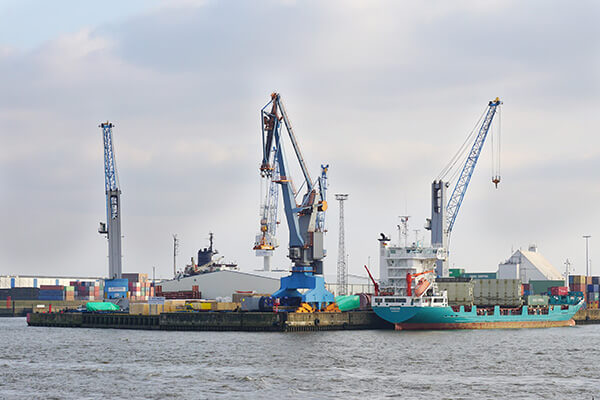The U.S. Army Corps of Engineers denied Energy Transfer Partners LP a permit to build a section of the $3.8 billion Dakota Access Pipeline in North Dakota after weeks of opposition from Native Americans, environmentalists and other groups.
“There’s more work to do” in exploring alternative routes, Jo-Ellen Darcy, the corps’ assistant secretary for civil works, said in a statement Sunday, rejecting the company’s request for a permit to route the line under Lake Oahe. The move punts a decision to the administration of President-elect Donald Trump. He expressed support for Dakota Access as recently as Dec. 1.
Protests against the crude-oil pipeline have resulted in hundreds of arrests and drawn support from celebrities. The standoff is emblematic of a broader effort by environmentalists to stall oil and gas pipelines, which they say aren’t needed and hurt the nation’s progress in reducing its reliance on fossil fuels. Protesters who have camped for months in North Dakota had been told the area would be closed on Monday and they would have to move to designated protest zones.
Energy Transfer Partners and Sunoco Logistics Partners LP called the move “a purely political action” in a statement Sunday, adding that they are fully committed to bringing the project to completion.
“This is nothing new from this administration, since over the last four months, the administration has demonstrated by its action and inaction that it intended to delay a decision in this matter until President Obama is out of office,” the companies said in the statement.
Energy Transfer Partners slid as much as 3.7 percent to $33.12 in New York on Monday. The stock was down 3.6 percent to $33.16 at 9:35 a.m. local time. Parent company Energy Transfer Equity LP fell as much as 1.8 percent to $16.18 while Sunoco Logistics declined as much as 3.4 percent to $22.40.
The setback may be temporary. While the decision by President Barack Obama’s administration prevents the pipeline’s completion for now, analysts and Republican leaders have said Energy Transfer will probably receive the approval it seeks after Trump takes office in January.
Trump Administration
“The Obama administration’s refusal to issue an easement for the Dakota Access Pipeline violates the rule of law and fails to resolve the issue,” North Dakota Senator John Hoeven, a Republican, said in an e-mail. “Instead, it passes the decision off to the next administration, which has already indicated it will approve the easement, and in the meantime perpetuates a difficult situation for North Dakotans.”
Hoeven called for the protesters to immediately vacate the site.
The Trump administration can probably overturn the Corps’ decision and issue the required easement soon after taking power, Elvira Scotto, an analyst at RBC Capital Markets, said in a note Sunday night.
Dakota Access has been central to the intensifying debate over the need for new pipelines in the U.S. It has become a rallying point for the anti-fossil fuel movement and has drawn intense opposition from Native Americans who say it’ll damage culturally significant sites.
“We wholeheartedly support the decision of the administration,” Dave Archambault II, tribal chairman of the Standing Rock Sioux Tribe, said in a statement on Sunday. “In a system that has continuously been stacked against us from every angle, it took tremendous courage.”
The pipeline could help cut costs for drillers in North Dakota’s Bakken shale region that have turned to more costly rail shipments when existing pipes filled up. Dakota Access, with a capacity of about 470,000 barrels a day, would ship about half of the current Bakken crude production and enable producers to access Midwest and Gulf Coast markets.
The permit would be for the final section of the pipeline, which spans four states. The project was originally slated to be operational at the end of this year.
“The thoughtful approach established by the Army today ensures that there will be an in-depth evaluation of alternative routes for the pipeline and a closer look at potential impacts,” Interior Secretary Sally Jewell said in an e-mail.
Energy Transfer owns the project with Phillips 66 and Sunoco Logistics. Marathon Petroleum Corp. and Enbridge Energy Partners LP announced a venture in August that would also take a minority stake in the pipeline.

Oil advanced as Iraq said it pledged to cooperate with OPEC to reach an agreement this week that’s acceptable to all members.
Futures rose as much as 2.7 percent in New York after earlier declining. Iraq’s Oil Minister Jabbar al-Luaibi said Monday he’s “optimistic” a deal will be reached at OPEC’s summit in Vienna on Wednesday.
Saudi Arabia previously said that the producer group doesn’t necessarily need to curb oil output, after pulling out of a scheduled meeting with non-members including Russia.
“The market is going to be like a yo-yo reacting to headlines surrounding the Nov. 30 Vienna meeting,” Bart Melek, the head of global commodity strategy at TD Securities in Toronto, said by telephone. Statements out of Iraq lead to the assumption that it is likely a deal to cut output will be reached, he says.
The Organization of Petroleum Exporting Countries is heading into the last stretch of negotiations before its November 30 meeting to adopt a supply deal that was first floated in September. Oil prices whipsawed last week as various OPEC members and Russia tried to position themselves ahead of a final accord to reduce production. Ministers from Algeria and Venezuela headed to Moscow on Monday to get the biggest non-OPEC producer on board.
West Texas Intermediate for January delivery rose $1.02 to $47.08 a barrel at 10:08 a.m. on the New York Mercantile Exchange. Total volume traded Monday was 31 percent higher than the 100-day average.
Brent for January settlement advanced $1.01, or 2.1 percent, to $48.25 a barrel on the London-based ICE Futures Europe exchange. The global benchmark traded at a $1.17 premium to WTI.
Saudi Stance
While Saudi Arabia has pushed to reverse OPEC’s pump-at-will policy, Energy Minister Khalid Al-Falih said Sunday the oil market would recover in 2017 even without cuts as consumption grows in countries such as the U.S., according to Saudi newspaper Asharq al-Awsat.
Russia has so far resisted requests to join a cut, offering instead to freeze production at current levels. Energy Minister Alexander Novak has insisted that OPEC reach an internal consensus on output curbs before Russia considers joining an accord. Algerian Energy Minister Noureddine Boutarfa presented a proposal Saturday to Iranian Oil Minister Bijan Namdar Zanganeh for an OPEC cut of 1.1 million barrels a day, according to an Iranian oil ministry official.
“The past weeks’ back and forth of diplomacy reveals how small the common denominator is,” Norbert Ruecker, head of commodity research at Julius Baer Group Ltd. in Zurich, said by e-mail. “Chances for a deal are high but we remain skeptical that it has teeth and see no lasting impact on prices.”
Oil-market news:
Iran’s Persian Gulf Petrochemical Industries Co. is in talks with Asian companies to raise as much as 1 billion euros ($1.1 billion) for an expansion including a methanol project intended to serve China and other Asian customers.
Shale drillers have added 158 rigs since May, according to Baker Hughes Inc. At the same time, companies such as Chesapeake Energy Corp. and EOG Resources Inc. have boosted efficiency by cramming more sand into wells, aiming to extend their reach miles further.

Activist shareholders plan a record number of resolutions focused on climate change at U.S. company annual meetings in 2017, even as President-elect Donald Trump looks set to loosen environmental regulations.
Based on filings so far, U.S. companies are on track to face roughly 200 resolutions on climate matters at their shareholder meetings next year, according to Rob Berridge, who follows the subject for Ceres, a sustainability advocacy group.
There were 174 such resolutions this year, Berridge said, compared with 167 in 2015 and 148 in 2014. Many have been directed at big oil and gas companies, though other sectors have also been targeted, including technology and retail.
Activist shareholders broadly aim to curb companies’ carbon emissions and make energy usage more efficient, or at the very least, to draw the attention of companies and investors to climate change as an urgent problem.
They have had some limited success. Investors at Exxon Mobil Corp the world’s largest publicly traded oil producer, passed a measure this year that could lead to an environmental activist joining its board. “Our position is that the risk of climate change is clear and warrants action,” said Exxon spokesman Alan Jeffers.
The rising number of shareholder votes reflects a growing concern among big investors about the environment, encouraged by steps by some boards to embrace reforms.
Deadlines are fast approaching to get resolutions on the ballot for shareholder meetings to be held in the spring.
The election victory of Trump, who is set to take over as U.S. president on Jan. 20, only seems to have added impetus.
On the campaign trail, Trump dismissed human-caused climate change as a “hoax” and pledged to dismantle the Environmental Protection Agency. He also threatened to withdraw the United States from the landmark 2015 Paris Agreement to combat climate change, although he appeared to step back from that position on Tuesday.
He vowed instead to revive the U.S. coal industry, encourage oil drilling and to scale back regulation of the energy sector.
“Despite what the administration may or may not do, I really believe that corporations understand the risks posed by climate change,” said Danielle Fugere, president of As You Sow, a California nonprofit campaign group. It sponsored 18 climate-related shareholder resolutions in 2016 and expects to file a bigger number next year.
One resolution for 2017 calls on Anadarko Petroleum Corp to report on how it would address the risk of so-called stranded assets, such as high-cost deepwater project investments, that might be caused by a drop in demand for oil and gas. The idea won support from 42 percent of shares voted at the company’s 2016 meeting, up from 29 percent in 2015.
Anadarko’s board last year called the idea “unnecessary and unproductive.” Spokesman John Christiansen said it is reviewing the proposal.
To be sure, among S&P 500 companies, investor support for climate resolutions has been relatively weak, holding steady around 22 percent since 2014, according to research firm Fund Votes.
But activists often won more backing for ideas such as urging companies to report on their strategy for dealing with climate change, according to the Sustainable Investments Institute, a research firm specializing in shareholder votes, supported by universities, pension funds and other institutional investors.
Anne Simpson, director of sustainability for the California Public Employees’ Retirement System (Calpers), which manages about $300 billion, said it plans to file or back resolutions at U.S. oil and gas companies for 2017, though she declined to discuss specifics.
Last year the boards of mining companies including Rio Tinto Plc and Glencore Plc endorsed resolutions Calpers submitted calling for reports on climate risk, and the measures passed by wide margins.
More companies will likely embrace shareholder proposals to head off disruption caused by climate change, Simpson said.
“Economics is driving this, not politics,” she said.

Money managers, producers and consumers made the biggest bets on West Texas Intermediate crude prices in nine years, amid signals more volatility is coming.
Global markets were roiled after Donald Trump’s election as U.S. president and as OPEC continued negotiations on a deal to cap output. The U.S. dollar climbed to the highest since January. A measure of oil volatility surged last week to a seven-month high, a sign that traders were anticipating bigger price swings.
Wagers on higher and lower prices held by speculators and hedgers reached 1.47 million contracts in the week ended Nov. 15, the most since 2007, U.S. Commodity Futures Trading Commission data show. Trading volume of calls giving investors the right to purchase WTI futures rose to a record that day. The CBOE Crude Oil Volatility Index reached the highest since April. Brent oil shorts, bets that prices will fall, rose to the highest in more than two years.
“There’s tension in the market, with both producers and consumers worried about what OPEC does or won’t do on Nov. 30,” said Tim Evans, an energy analyst at Citi Futures Perspective in New York. “They want to be protected from surprising price moves.”
OPEC Meeting
Investors are weighing the chances that the Organization of Petroleum Exporting Countries will complete a deal to cap output at its Nov. 30 meeting in Vienna. While Saudi Arabian Energy Minister Khalid Al-Falih told Al Arabiya television he’s optimistic a deal will be reached, only seven of 20 analysts surveyed by Bloomberg last week expect the group to set output targets for its members.
OPEC agreed in September to cut their collective output to 32.5 million to 33 million barrels a day and has been trying to persuade other suppliers, notably Russia, to join the cuts. OPEC Secretary General Mohammed Barkindo said he’s confident the group can reduce record oil inventories and bring forward the rebalancing of the market.
“The Saudis are working hard to reach a deal,” said John Kilduff, a partner at Again Capital LLC, a New York-based hedge fund that focuses on energy. “You don’t fight the Fed in the bond market and when it comes to oil you don’t fight the Saudis.”
The September agreement marked the end of OPEC’s two-year long experiment with pumping at will. Saudi Arabia led the group in the effort to grab market share and curb the development of more expensive reserves such as U.S. shale.
U.S. Production
While U.S. production has dropped from last year’s 44-year high, the decline is slowing. The Energy Information Administration this month raised its output forecast for 2017. Rigs targeting oil in the U.S. rose the most in 16 months last week, according to Baker Hughes Inc.
Producers and merchants increased short positions, or protection against lower WTI prices, to the highest level since March 2011. They added 66,613 bearish contracts over the past two weeks as prices retreated from last month’s peak at above $50 a barrel.
“The Saudis want higher prices but won’t sacrifice just to see a major competitor, U.S. shale, benefit,” said Sarah Emerson, managing director of ESAI Energy Inc., a consulting company in Wakefield, Massachusetts. “The Trump election changes things. In one day the U.S. shale business got better. The government will be more responsive to the industry.”
Money managers’ net-long position in WTI advanced for the first time since mid-October, climbing by 3,906 futures and options to 163,321. Shorts climbed 14 percent while longs rose 8.1 percent. WTI gained 1.8 percent to $45.81 a barrel in the report week. It rose 2.7 percent to $46.93 as of 8:48 a.m. on Monday.
Brent Bets
In the Brent market, money managers increased short positions by 11 percent to 157,016 during the week, the highest level since September 2014, according to data from ICE Futures Europe. The net-long position in the global benchmark slipped by 4.6 percent during the week to the lowest since January.
In fuel markets, net-bullish bets on gasoline decreased 35 percent to 25,796 contracts, as futures slipped 2.5 percent in the report week. Money managers were net-short 393 contracts of ultra low sulfur diesel, from net-long 7,791 the previous week. Futures advanced 0.2 percent.
“I suspect that when the OPEC meeting is over there will have been a lot more smoke than fire,” said Michael Lynch, president of Strategic Energy & Economic Research in Winchester, Massachusetts. “If they don’t come up with a convincing agreement, they’ll be forced to revisit the issue before long.”

Geologists say a new survey shows an oilfield in west Texas dwarfs others found so far in the United States, according to the US Geological Survey.
The Midland Basin of the Wolfcamp Shale area in the Permian Basin is now estimated to have 20 billion barrels of oil and 1.6 billion barrels of natural gas, according to a new assessment by the USGS.
That makes it three times larger than the assessment of the oil in the mammoth Bakken formation in North Dakota.
The estimate would make the oilfield, which encompasses the cities of Lubbock and Midland — 118 miles apart — the largest “continuous oil” discovery in the United States, according to the USGS.
“This oil has been known there for a long time — our task is to estimate what we think the volume of recoverable oil is,” assessment team member Chris Schenk told CNN – affiliate KWES Wednesday.
The term “continuous oil” refers to unconventional formations like shale, in which the oil exists throughout the formation and not in discrete pools. The USGS estimates how much oil is considered to be undiscovered but technically recoverable.
“Even in areas that have produced billions of barrels of oil, there is still the potential to find billions more,” Walter Guidroz, coordinator for the USGS Energy Resources Program said in a statement. “Changes in technology and industry practices can have significant effects on what resources are technically recoverable, and that’s why we continue to perform resource assessments throughout the United States and the world.”
Oil has been produced in the Wolfcamp area since the 1980s by traditional vertical wells — but now companies are using horizontal drilling and hydraulic fracturing to tap the continuous oil reserve. More than 3,000 horizontal wells are currently operating, according to the USGS.
Morris Burns, a former president of the Permian Basin Petroleum Association, told KWES the low price of oil — currently around $46 a barrel — means the oil will sit underground for the foreseeable future.
“We are picking up a few rigs every now and then but we won’t see it really take off until we (get) that price in the $60 to $65 range,” Burns told the station.
“When we talk about that many millions of barrels of oil in the ground, that doesn’t mean we can recover it all. We recover in the neighborhood of 50 to 60 percent,” Burns said.
Last spring, CNN reported that “fracking” now accounted for more than half of all U.S. oil output. Back in 2000, there were just 23,000 fracking wells pumping about 102,000 barrels of oil a day. Last March there were 300,000 fracking wells, churning out 4.3 million barrels per day.
The fracking production, led by Permian Basin, Bakken formation and Eagle Ford, also in Texas, caused oil prices to tumble — making the $100 barrel ancient history — to as low as $25 a barrel early this year.

Copyright: CNN
Oil fell to its lowest in three months on Monday, as the prospect of another year of oversupply and weak prices overshadowed chances that Opec will reach a deal to cut output.
Donald Trump’s surprise win in last week’s US presidential election boosted the dollar and stocks but undermined oil. Crude has also fallen because of waning expectations that the world’s largest exporters will agree to reduce production this month.
Brent crude futures fell 50 cents on the day to $44.25 a barrel by 2:50pm GMT, while NYMEX crude futures dropped by 57 cents to $42.84 a barrel.
“In the same way that a strong Opec agreement was needed to continue the rally above $55, a lack of agreement will be needed to break below $40 and right now, we’re at $45,” Petromatrix strategist Olivier Jakob said.
Opec plans to cut or freeze output, but analysts doubt the group’s ability to reach an agreement at its meeting on 30 November.
Opec said on Friday its output hit a record 33.64 million barrels per day in October, and forecast an even larger global surplus in 2017 than the International Energy Agency (IEA) on Thursday.
Yet, Saudi Energy Minister Khalid al-Falih has said it was imperative for Opec to reach a consensus on activating a deal made in September in Algiers to cut production.
“Opec know what needs to be done but too few members will agree to take the production pain for the price gain, knowing also that the price gain incentivises non-Opec to produce more, lengthening the rebalancing process,” PVM Oil Associates analyst David Hufton said.
The dollar index hit an 11-month peak on Monday, driven by an aggressive sell-off in bonds that has pushed Treasury yields to their highest since January.
Ordinarily, a strong dollar would push oil lower, but the correlation between the two is at its most positive in two months, suggesting they are more likely to move in lockstep with one another than in opposite directions.
Data from the InterContinental Exchange on Monday showed investors delivered the largest weekly cut on record to their bets on a sustained rise in the price of oil.

Mexico’s state oil company Pemex has laid out the broad strokes of a new strategy that could dramatically expand its use of partnerships in the Mexican exploration and production sector over the next five years.
The plans open up the possibility of more than 160 new opportunities for private companies over the next two years.
Pemex has already announced plans for the farm-down this year of an interest in the deep-water Trion discovery, and said 2017 would also bring other farm-outs in the shallow-water area of Ayin-Batsil and the onshore areas of Ogarrio and Cardenas-Mora. The company’s latest 2016-2021 business plan also labels 2017 as its target date for partnerships in the extra-heavy oil field of Ayatsil-Tekel-Utsil and the tricky but promising region of Chicontepec, as well as seven more unspecified onshore areas in the northern and southern parts of the country.
The strategy also sets out ambitious plans for 2018, with six deals proposed for shallow waters in the northern part of the country, 64 onshore agreements in the north and south and 86 natural gas contracts in the Burgos and Veracruz areas.
“Pemex’s business plan is a good roadmap, but short and medium-term challenges remain,” political risk consultancy Eurasia Group wrote in a note. “Operational challenges will remain substantial and many of the projects are likely to face delays.”
Pemex only recently gained the ability to take on operating partners in its projects as part of reforms passed in 2014 to end its nearly 80-year monopoly.
The state-led company has touted its new ability as being crucial to helping make up for its declining production curve and bringing in new technology and best practices.
A small number of farm-outs were announced with the passage of implementing legislation in 2014, but details since then have been scant other than Trion. Industry executives have called for more opportunities.
When it comes to exploration rights, by law Pemex must sign contracts for stakes in its projects via an open public bid round run by Mexican oil regulators, not just by direct negotiations.
Pemex did not provide many details on the projects mentioned, merely offering a list of “business opportunities” as part of its roadmap forward.
The strategy was unveiled as Pemex comes under pressure to show progress and activity on areas assigned in the process known as Round Zero.
That process divvied up what fields the Mexican player could retain following reforms but, without activity, acreage reverts back to regulators.
“The plan is very ambitious but I think it’s rightly so,” said Francisco Monaldi, adjunct professor of political economy of oil at Rice University in Houston, suggesting executives aim to position Pemex to take full advantage of the abilities offered by the energy reform.
Chiefly, Pemex will need to find a “winning formula” that can incentivise new operators to come in, and the process for the deep-water Trion block may end up being a model for that going forward, according to Luis Miguel Labardini, partner at Marcos y Asociados in Mexico City.
Ongoing discussions surrounding that joint operating agreement, with lots of feedback from international oil companies, led to the jettisoning of provisions that could have limited the autonomy of new partners, such as the ability of Pemex to unilaterally remove the new operator despite holding a minority stake in the project.
Some of the areas mentioned, notably the Ayatsil-Tekel-Utsil extra-heavy oil field and the Chicontepec region, also have higher production costs that could make economics difficult if lower oil prices persist.
Experts also acknowledged future political risk. The term of energy reform proponent President Enrique Pena Nieto is up in 2018, and the administration at present stands in a weak position due to multiple corruption scandals and its inability to stem violence from drug cartels.

Oil traded near $44 a barrel in New York amid a broader market rally driven by speculation Hillary Clinton’s chances of winning the U.S. election increased after the FBI said her handling of her e-mails wasn’t a crime.
Futures rose as much as 2.1 percent in New York following the Federal Bureau of Investigation’s report. The S&P 500 Index was set for its biggest gains since June and the dollar rose against its peers for the first time in seven sessions. Russia, the world’s biggest energy producer, is “on board” with an OPEC agreement to limit crude oil production to help re-balance the market, according to OPEC Secretary General Mohammed Barkindo.
“The U.S. election is front and center in all the markets,” said Chris Kettenmann, chief energy strategist at Macro Risk Advisors LLC in New York. “There was talk over the weekend of Russia agreeing to limit production in cooperation with OPEC, but we need to see a resolution from the Nov. 8 vote before the focus shifts to Nov. 30.”
Oil retreated below $45 a barrel following the failure of the Organization of Petroleum Exporting Countries to agree on output quotas for member countries on Oct. 28, which must happen before a deal can be finalized. OPEC pumped at a record rate in October, according to data compiled by Bloomberg.
West Texas Intermediate for December delivery rose 32 cents, or 0.7 percent, to $44.39 a barrel at 11:26 a.m. on the New York Mercantile Exchange. The contract slid 59 cents to $44.07 on Friday, the lowest close since Sept. 20. Prices fell 9.5 percent last week, the most in almost 10 months.
Election Focus
Brent for January settlement rose 4 cents to $45.62 a barrel on the London-based ICE Futures Europe exchange. Prices declined 8.3 percent last week, the most since January. The global benchmark traded at an 68-cent premium to January WTI.
“The stock market is up on the increasing likelihood of a Hillary Clinton victory,” said Thomas Finlon, director of Energy Analytics Group LLC in Wellington, Florida. “This is also strengthening the dollar, which is weighing on commodities.”
The Bloomberg Dollar Spot Index, a gauge of the greenback against 10 major peers, rose as much as 0.5 percent. A stronger U.S. currency reduces the appeal of dollar-denominated raw materials as an investment.
A magnitude 5 earthquake struck near Cushing, Oklahoma, the nation’s largest crude-storage hub, prompting some pipeline operators to shut operations at the site as a precaution. Oklahoma’s oil and gas regulator reported that all pipelines under its jurisdiction were operating again after shutting down as a precaution because of the temblor, centered less than 2 miles west of Cushing.
Gasoline dropped to the lowest level in seven weeks after Colonial Pipeline Co. restarted the largest U.S. line for the fuel Sunday, six days after an explosion and fire in Alabama during planned work.
December gasoline futures fell 1.5 percent to $1.3579 a gallon after touching $1.3561, the lowest since Sept. 20.

Some of the world’s biggest oil companies, including Saudi Aramco and Royal Dutch Shell, pledged on Friday to invest $1 billion to develop climate-friendly technologies as a global deal to wean the world off oil came into force.
The Oil and Gas Climate Initiative (OGCI), which also includes Total, BP, Eni, Repsol , Statoil, CNPC, Pemex and Reliance Industries, launched the Climate Investments fund which will invest in technologies to reduce carbon emissions but which will also help an increase gas use.
The companies pledged to use a large share of the $1 billion for speeding up carbon capture, use and storage (CCUS) in gas-fired power plants and towards reducing leakages of methane, one of the most polluting greenhouse gases.
“If we can reduce and build the technologies to monitor and reduce fugitive methane emissions that’s like an essential licence for us to be able to advocate natural gas,” BP Chief Executive Bob Dudley told journalists.
The investment is nevertheless dwarfed by the joint annual spending of the member companies, even as they battle one of the longest downturns in the sector’s history. Shell, Total, BP, Statoil, Repsol and Eni are expected to spend nearly $100 billion in 2016.
The 10 firms, which jointly produce around 20 percent of the world’s oil and gas, have already screened a list of 200 CCUS-related technologies and are now assessing which one or ones to develop to commercial scale.
The group will also invest in improving efficiency in transport and energy-intensive industries.
The announcement coincides with the official coming into force of the 2015 Paris Agreement, intended to wean the world economy off coal, oil and gas in the second half of this century in order to slash carbon emissions.
The oil and gas sector, which is directly responsible for 5 percent of manmade greenhouse emissions and the use of its products for another 32 percent, is under growing pressure from investors and the general public to help fight climate change.
“If the CEOs of the 10 largest corporations meet six times during the year it’s not for philanthropy, it’s real business,” said Patrick Pouyanne, chief executive of Total.
Critics have said oil companies need to do more to reduce emissions and to shield themselves from climate change risks.
“Companies could be worth considerably more, not less, if they aligned their portfolios with 2 C by exercising capital discipline and opting for lower-cost upstream projects that make both financial and climate sense,” said Anthony Hobley, chief executive of think tank Carbon Tracker Initiative.

Asian energy stocks fell with oil after the world’s biggest crude producers failed to agree on supply cuts, while rising metals prices in China spurred gains in mining shares. Gold was buoyed by haven demand following the reopening of an FBI probe into Hillary Clinton.
The MSCI Asia Pacific Energy Index and crude both slipped to one-month lows after the Organization of Petroleum Exporting Countries ended two days of talks on Saturday without agreeing any individual quotas. A gauge of raw-materials producers climbed toward its highest level in almost four months as aluminum and zinc rallied to multi-year highs in Shanghai. Gold rose for a third day after a survey pointed to cooling support for Clinton before next week’s U.S. presidential election, while the rand gained versus major peers.
Global equities have lost ground in October as mixed corporate earnings meld with investor anxiety ahead of the Nov. 8 vote in the U.S. and expectations the Federal Reserve will hike interest rates before the year is out. The S&P 500 Index slid 20 points in about 40 minutes on Friday amid news the Federal Bureau of Investigation was again looking into Clinton’s use of private e-mail while secretary of state, an issue that has dogged her campaign. OPEC talks over two days in Vienna yielded little more than a promise that the world’s top oil producers would keep discussing ways to stabilize the market.
“Until the election, the general theme will be uncertainty, which will have implications not just on the stock market, but on the dollar and Treasuries,” said Chad Morganlander, a money manager in Florham Park, New Jersey at Stifel, Nicolaus & Co., which oversees about $180 billion. “The probability that was factored into the market and the global financial system was a Hillary Clinton victory – investors now need to square their books going into the election based on whatever new odds come out.”
Stocks
A gauge of energy shares on the MSCI Asia Pacific Index was down 0.2 percent as of 3:06 p.m Tokyo time, while a measure of raw-materials producers added 0.8 percent. About the same number of stocks rose as fell on the dollar-denominated benchmark, which has barely moved in October following a third-quarter gain of 8.4 percent that marked its best performance in more than four years.
Japan’s Topix index held near its highest level since April and the Shanghai Composite Index declined for a fourth day. Hong Kong’s Hang Seng Index advanced for the first time in a week, while markets in India and the Philippines were shut for holidays.
AIA Group Ltd. shares slumped as much as 7.2 percent after China UnionPay Co. halted credit and debt card payments for most insurance policies in Hong Kong, making it harder to conduct transactions with Chinese visitors that accounted for about half of the company’s sales in the city. Nippon Yusen KK and Mitsui O.S.K. Lines Ltd. — Japan’s two largest shipping companies — surged more than 5 percent in Tokyo after they agreed to merge their container operations with those of third-ranked Kawasaki Kisen Kaisha Ltd., which added less than 1 percent.
Futures on the S&P 500 Index rose 0.3 percent, after earlier retreating as much as 0.4 percent. An ABC/Washington Post tracking survey released Sunday gave Clinton 46 percent support from likely voters, to Trump’s 45 percent. Clinton was ahead by 12 points a week earlier.
“The race remains very tight and markets are far too complacent about the end result,” said Matthew Sherwood, head of investment strategy in Sydney at Perpetual Ltd., which manages about $21 billion. “If the polls tighten more, or the FBI investigation dominates the headlines, there could be a recalibration in market prices this week.”
Commodities
Crude oil fell 0.4 percent to $48.50 a barrel in New York. OPEC ended a meeting on Friday without reaching a deal on country quotas, according to delegates who took part in the discussions. Major producers from outside OPEC finished talks with the group on Saturday without any supply commitments, Brazil’s Oil and Gas Secretary Marcio Felix said. Oil has fluctuated near $50 amid uncertainty about whether OPEC can implement the first supply cuts in eight years at its official November meeting.
“Talks over the weekend make it seem less likely there will be an agreement on production cuts,” said Ric Spooner, a chief market analyst at CMC Markets in Sydney. “The market has probably made a fair bit of the adjustment, but I wouldn’t be surprised to see oil fall further into the $47 range.”
Gold added 0.2 percent, after rallying 0.6 percent on Friday. The metal’s gains reflect “safe-haven buying after the FBI reopened its inquiry into Hillary Clinton’s use of a private e-mail server,” Australia & New Zealand Banking Group Ltd. analysts wrote in a note on Monday.
Aluminum and zinc extended gains in Shanghai as investors bet that strong domestic demand, surging coal prices and logistical issues will underpin prices. Aluminum rose as much as 3.1 percent to its highest level since September 2014, having jumped by about 10 percent last week. Zinc climbed to the highest since March 2011.
Currencies
The Bloomberg Dollar Spot Index, a gauge of the greenback against 10 major peers, rose less than 0.1 percent after retreating 0.3 percent from a seven-month high in the last session. It’s climbed 2.2 percent this month, the biggest gain since May.
While the Fed is seen leaving policy unchanged at a review this week, futures prices indicate a 69 percent chance of an interest-rate hike at its December meeting, up from 59 percent at the end of September. American data on Monday are forecast to show personal spending and income both increased in September, based on Bloomberg surveys of economists.
The rand strengthened 0.6 percent after City Press newspaper reported that South African prosecutors may drop fraud charges against Finance Minister Pravin Gordhan, who has been a key driver of a campaign to maintain the nation’s investment-grade credit rating. The National Prosecuting Authority said Sunday there were no such plans.
The Mexican peso fluctuated near a two-week low versus the dollar, after three days of losses. Mexico’s currency tends to fall when U.S. presidential candidate Donald Trump gains ground in polls, reflecting concern about his pledges to renegotiate a free-trade agreement and deport millions of undocumented immigrants.
South Korea’s won rose 0.3 percent, having earlier sank to a three-month low as President Park Geun-hye deals with an influence-peddling scandal that’s sparked calls by the ruling party for her to remove the prime minister. Prosecutors raided Park’s office over the weekend to investigate allegations her close friend Choi Soon-sil — a private citizen whom opposition lawmakers have linked to a religious cult — wielded influence on state affairs over an extended period.
China’s yuan strengthened 0.2 percent, paring its biggest monthly loss since May. The currency advanced from near a six-year low following Friday’s retreat in the dollar and as China’s clampdown on UnionPay payments for insurance products in Hong Kong provided support. The transactions have been used as a means of skirting capital controls to take funds out of the mainland.
Bonds
The yield on U.S. Treasuries due in a decade declined one basis point to 1.84 percent, after touching a five-month high of 1.88 percent on Friday. Sovereign debt in the world’s biggest economy has lost 1.2 percent on average this month, the worst performance since February 2015, a Bloomberg index shows.
The selloff in Treasuries may pause because the FBI’s investigation of Clinton could spur demand for the safest assets, said Hiroki Shimazu, an economist and strategist at the Japanese unit of MCP Asset Management in Tokyo.
China’s one-year interest-rate swaps rose four basis points to an 18-month high of 2.75 percent in Shanghai. The increase reflects speculation policy makers will seek to keep money rates high as they tackle asset bubbles and try to stem declines in the yuan.

Scroll to top

 Breaking Barriers and Building the Future18 March, 2025
Breaking Barriers and Building the Future18 March, 2025 Fundamental factors to strengthen Pemex12 August, 2019
Fundamental factors to strengthen Pemex12 August, 2019 Offshore Project Development: The Road to First Oil26 July, 2019
Offshore Project Development: The Road to First Oil26 July, 2019








